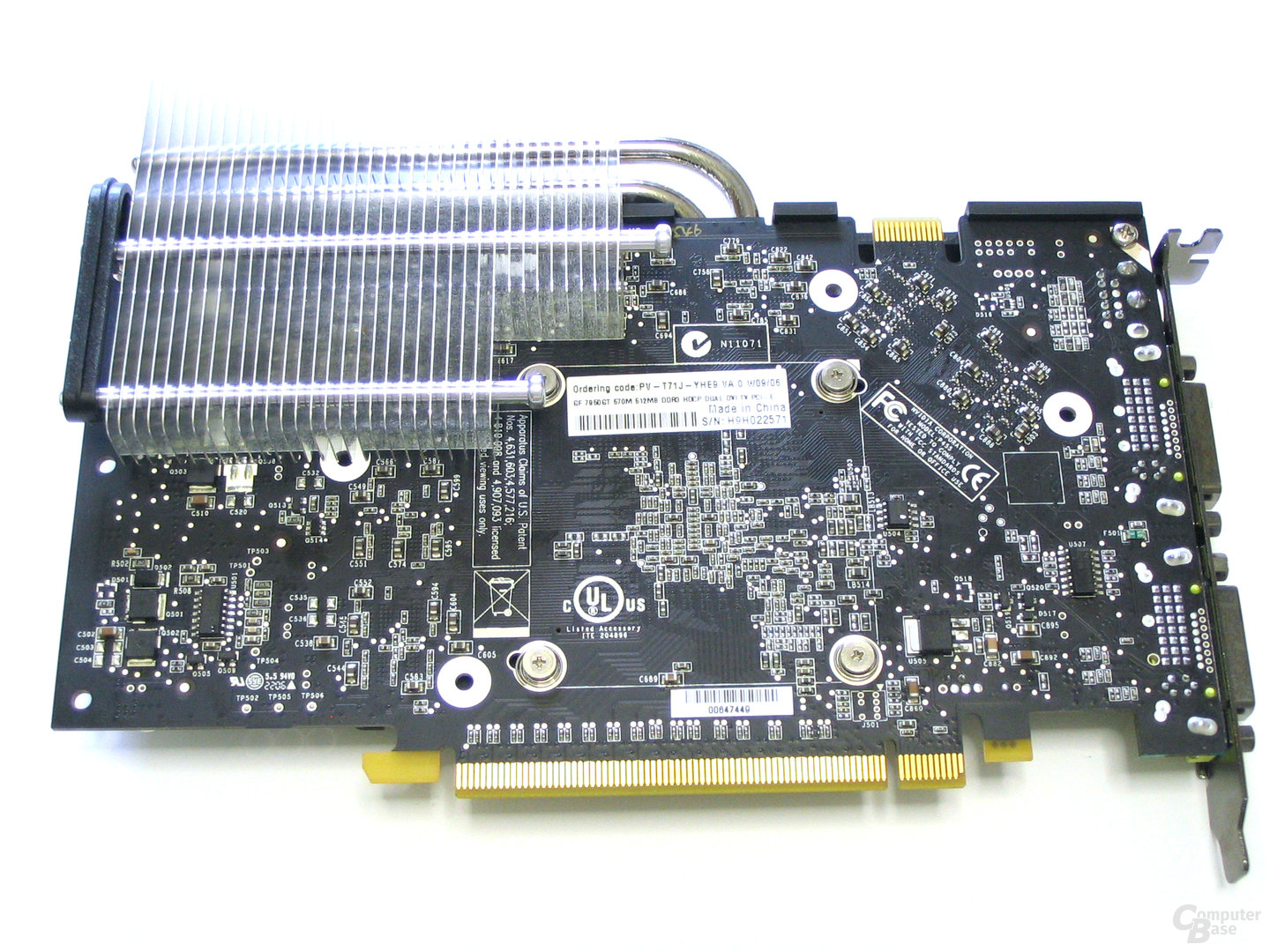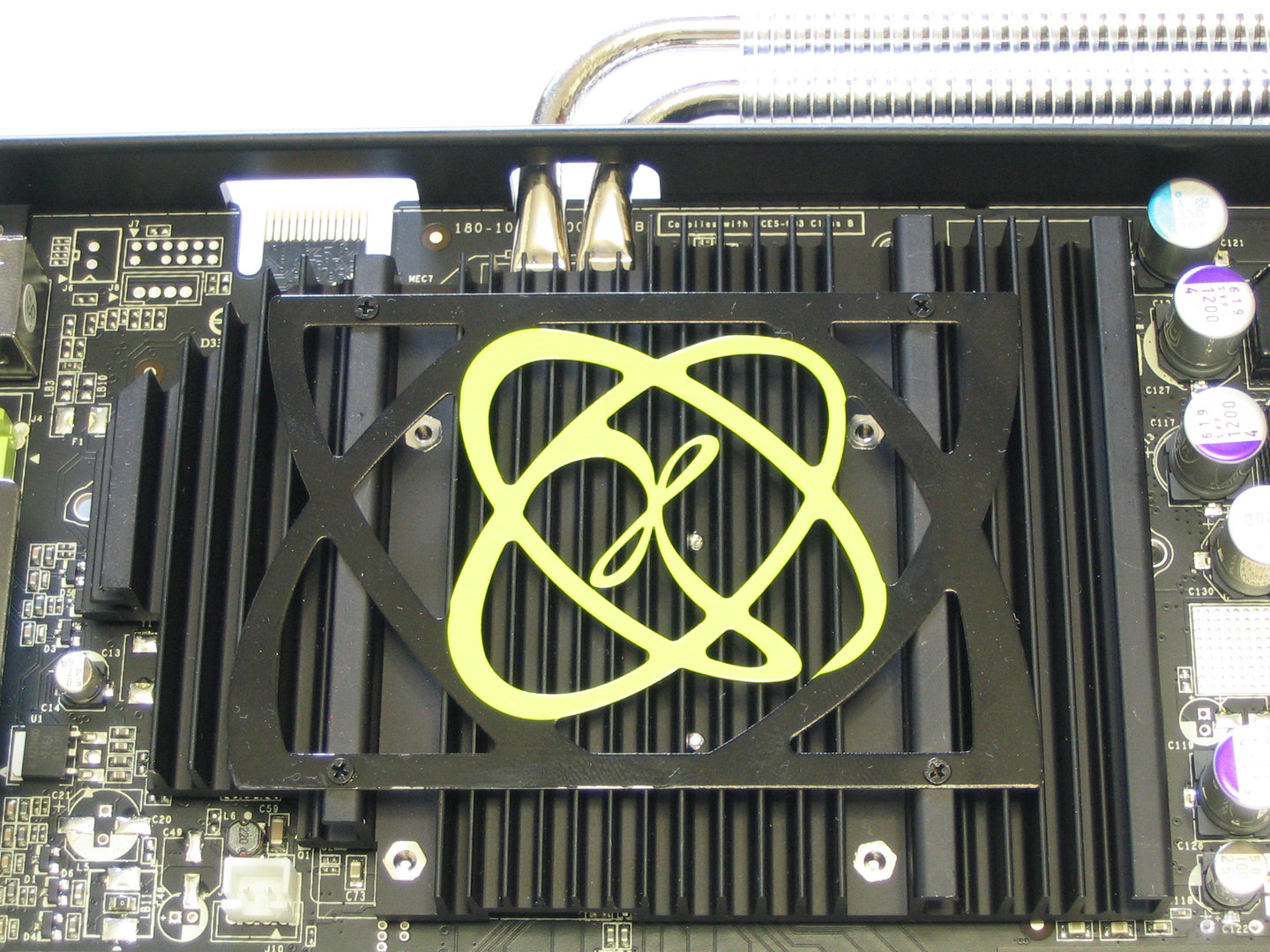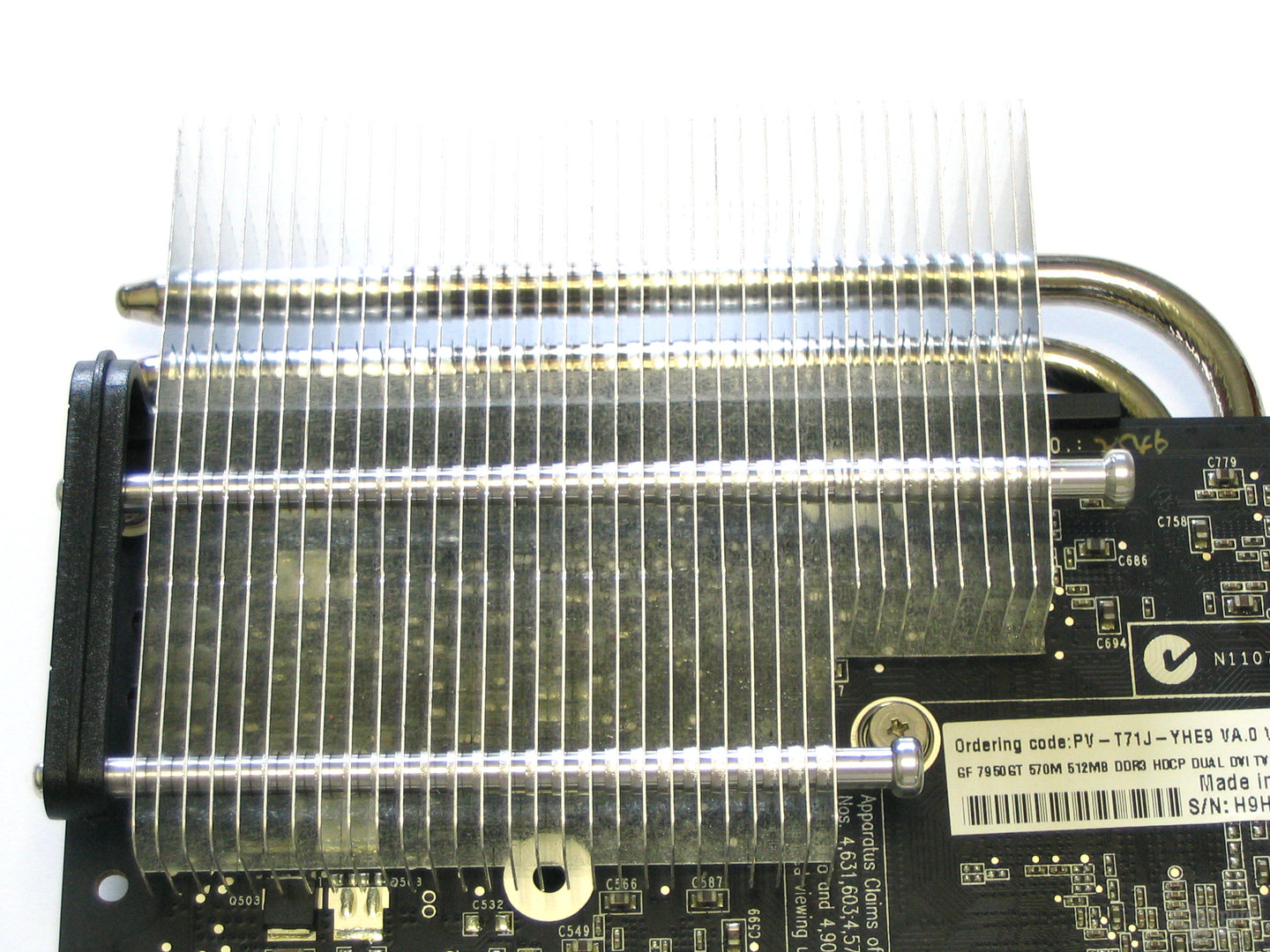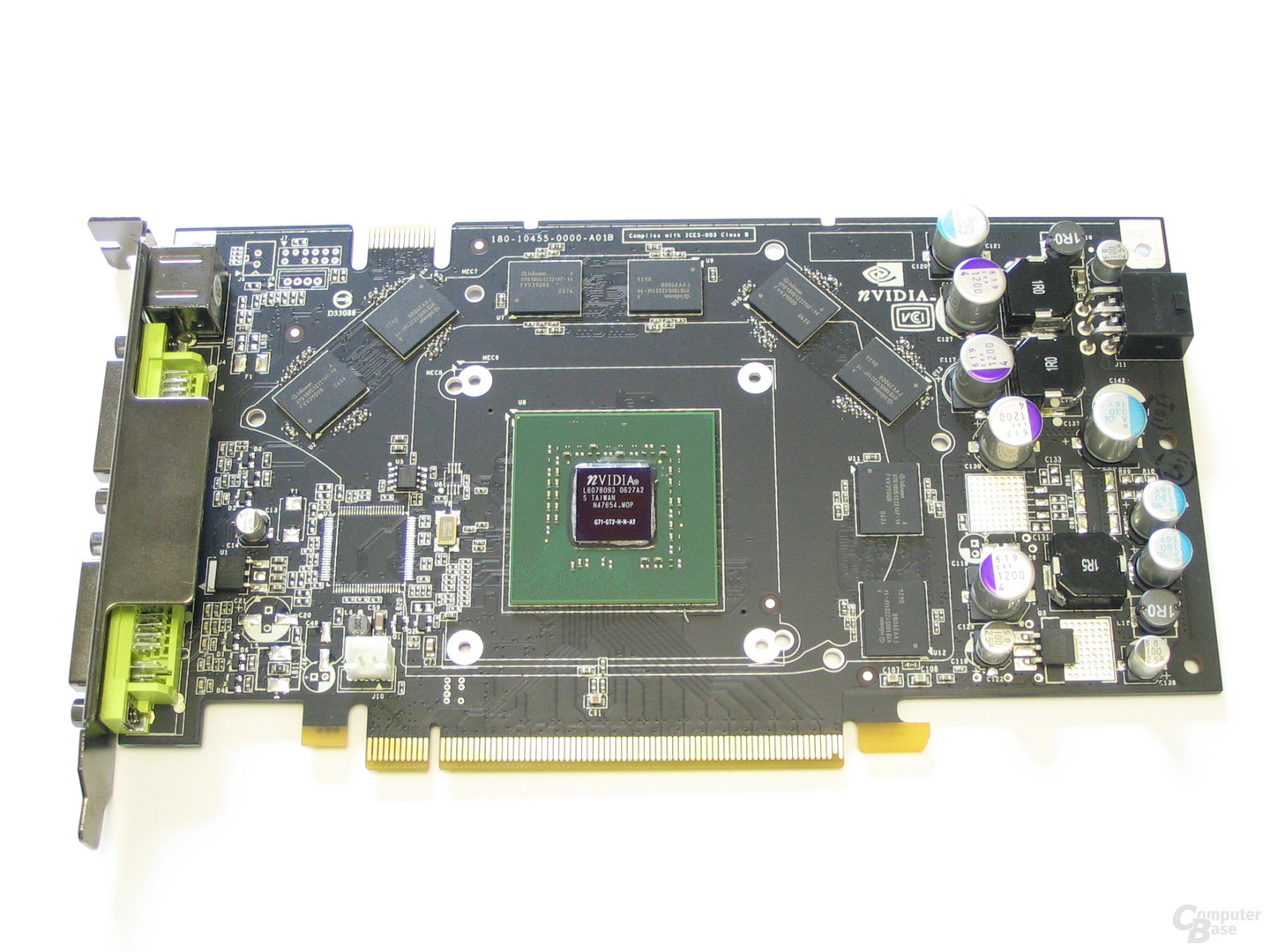15 years ago, Nvidia put the GeForce 7950 GT against the ATi Radeon X1950 Pro, which was not yet available. The tested XFX GeForce 7950 GT 570M convinced due to its high performance, the lower price and the silent passive cooling. The GPU garnished that with very high temperatures.
Table of contents
- 1 A faster GeForce 7900 GT or a slower GeForce 7900 GTX
- Solid performance in games
- Completely silent at extremely high temperatures
- Conclusion
A faster GeForce 7900 GT or a slower GeForce 7900 GTX
The GeForce 7950 GT could either be viewed as a faster GeForce 7900 GT or a slower GeForce 7900 GTX. Like these two models, it relied on a full expansion of the G71 GPU with 278 million transistors and 24 pixel pipelines. The GPU clock of 550 MHz was exactly in the middle between the GeForce 7900 GT with 450 MHz and the GeForce 7900 GTX with 650 MHz. At that time, product differentiation based on the clock rate was still common, today it no longer exists.
The XFX GeForce 7960 GT 570M clocked the GPU with a marginally higher frequency of 570 MHz. The 512 MByte graphics memory on the reference model was clocked at 700 MHz, with the XFX model it was 730 MHz and thus in both cases a little less than the 800 MHz of the GeForce 7900 GTX.
In the reference design, the GeForce 7950 GT was equipped with the same single-slot cooler that was used on the GeForce 7900 GT and GS. Due to the small radial fan, this was comparatively loud under load and not suitable for silent PCs. The manufacturer built in its own passive cooling design for the XFX GeForce 7950 GT 570M. This put on a copper plate for heat absorption and an aluminum heat sink on the front of the graphics card. In addition, two heat pipes conducted the heat to another aluminum heat sink on the back of the graphics card. The built-in GDDR3 memory was also covered by a cooling plate to dissipate its waste heat.
-
 XFX GeForce 7950 GT backside
XFX GeForce 7950 GT backside
Image 1 of 10
 XFX GeForce 7950 GT cooler
XFX GeForce 7950 GT cooler  XFX GeForce 7950 GT DVI ports
XFX GeForce 7950 GT DVI ports  XFX GeForce 7950 GT Heatpipe sideways
XFX GeForce 7950 GT Heatpipe sideways  XFX GeForce 7950 GT Heatpipe
XFX GeForce 7950 GT Heatpipe  XFX GeForce 7950 GT slot bracket
XFX GeForce 7950 GT slot bracket  XFX GeForce 7950 GT without cooler
XFX GeForce 7950 GT without cooler Solid performance in games
The overclocking of the XFX model was noticeable in the benchmarks in a one to two percent higher performance – free. Compared to a GeForce 7900 GT, between 16 and 22 percent more power was available, depending on the resolution and the activation of anti-aliasing and anisotropic filtering. Conversely, the losses on a GeForce 7900 GTX were between 9 and 13 percent. Compared to ATi graphics cards, the GeForce 7950 GT is between the Radeon X1800 XT and the X1900 XT.
«Previous performance rating 1280x1024Performancerating 1600x1200Rating 1280×1024 4xAA/16xAFRating 1600×1200 4xAA/16xAF Next»
- Performance rating 1280×1024 Unit: percent
- < li class = "chart__group">
- nVidia GeForce 7950 GX2125,9
- ATi Radeon X1950 XTX115,6
- nVidia GeForce 7900 GTX109,6
- ATi Radeon X1900 XTX108,4
- ATi Radeon X1900 XT105,6
- XFX GeForce 7950 GT 570M101,2
- nVidia GeForce 7800 GTX 512100,2
- nVidia GeForce 7950 GT100,0
- ATi Radeon X1800 XT93,0
- nVidia GeForce 7900 GT86,2
- nVidia GeForce 7800 GTX83,2
- ATi Radeon X1900 GT80,2
- nVidia GeForce 7900 GS79,6
- nVidia GeForce 7800 GT72 , 1
- ATi Radeon X1800 XL68,9
- nVidia GeForce 7600 GT62,2
- ATi Radeon X1800 GTO59,0
- nVidia GeForce 7600 GS41,9
- ATi Radeon X1600 XT38,7
- ATi Radeon X1600 Pro30,2
- ATi Radeon X1300 Pro21,5
-
- nVidia GeForce 7950 GX2138,9
- ATi Radeon X1950 XTX123,4
- ATi Radeon X1900 XTX113,8
< li class = "chart__row"> nVidia GeForce 7900 GTX112,7
- ATi Radeon X1900 XT109,0
- nVidia GeForce 7800 GTX 512 102,2
- XFX GeForce 7950 GT 570M101,4
- nVidia GeForce 7950 GT100.0
- ATi Radeon X1800 XT92.4
- nVidia GeForce 7900 GT83.9
- nVidia GeForce 7800 GTX80,1
- nVidia GeForce 7900 GS76,7
- ATi Radeon X1900 GT75,3
- nVidia GeForce 7800 GT68,6
- ATi Radeon X1800 XL65,8
- nVidia GeForce 7600 GT58.1
- ATi Radeon X1800 GTO55,3
- nVidia GeForce 7600 GS38,8
- ATi Radeon X1600 XT36,0
- ATi Radeon X1600 Pro28,8
- ATi Radeon X1300 Pro19,0
-
- nVidia GeForce 7950 GX2153,0
- ATi Radeon X1950 XTX127,2
- nVidia GeForce 7900 GTX114,8
- ATi Radeon X1900 XTX114,3
- ATi Radeon X1900 XT109,8
- XFX GeForce 7950 GT 570M101,8
- nVidia GeForce 7800 GTX 512100,5
- nVidia GeForce 7950 GT100 , 0
- ATi Radeon X1800 XT99,7
- nVidia GeForce 7900 GT83,4
- nVidia GeForce 7900 GS78,7
- nVidia GeForce 7800 GTX75,9
- ATi Radeon X1900 GT74,3
- ATi Radeon X1800 XL69,2
- nVidia GeForce 7800 GT64,6
- ATi Radeon X1800 GTO58,5
- nVidia GeForce 7600 GT55,4
- ATi Radeon X1600 XT36,4
- nVidia GeForce 7600 GS34,8
- ATi Radeon X1600 Pro27,5
- ATi Radeon X1300 Pro19,9
-
- nVidia GeForce 7950 GX2160,4
- ATi Radeon X1950 XTX133,4
- ATi Radeon X1900 XTX118,7
- nVidia GeForce 7900 GTX115,6
- ATi Radeon X1900 XT114,2
- XFX GeForce 7950 GT 570M101,1
- nVidia GeForce 7800 GTX 512 100,6
- ATi Radeon X1800 XT100,4
- nVidia GeForce 7950 GT100,0
- nVidia GeForce 7900 GT81.8
- nVidia GeForce 7900 GS76,8
- nVidia GeForce 7800 GTX73,8
- ATi Radeon X1900 GT73,8
- ATi Radeon X1800 XL67,0
- nVidia GeForce 7800 GT63,3
- ATi Radeon X1800 GTO56,8
- nVidia GeForce 7600 GT52,1
- ATi Radeon X1600 XT34,6
- nVidia GeForce 7600 GS32,2
- ATi Radeon X1600 Pro26,0
- ATi Radeon X1300 Pro15,3
Completely silent at extremely high temperatures
The passive cooling of a fast graphics card like the GeForce 7950 GT took its toll. The GPU temperatures were already very high at 69 ° C while idling, but the measured 125 ° C under load broke all records. The temperature threshold stored by XFX in the BIOS, from which the graphics card throttled its clock, was 130 ° C. It was therefore possible that the XFX GeForce 7950 GT 570M slowed down significantly under 3D load in the summer. In the test, despite the high temperatures, no stability problems were found in a 12-hour load scenario.
«Previous VolumeTemperaturePower consumptionOverclockability Next»
- Volume unit: dB (A)
- Idle (Windows):
- nVidia GeForce 7600 GS47,5 passive cooling
- ATi Radeon X1950 XTX47,5
- XFX GeForce 7950 GT 570M47,5
- nVidia GeForce 7800 GTX 51248,0
- ATi Radeon X1600 XT48,0
- nVidia GeForce 7950 GX248,0
- nVidia GeForce 7900 GTX48,5
- ATi Radeon X1800 GTO48,5
- ATi Radeon X1300 Pro49,0
- ATi Radeon X1800 XL49,0
- nVidia GeForce 7800 GTX49,5
- ATi Radeon X1900 GT50,0
- ATi Radeon X1900 XTX50,5
- nVidia GeForce 7600 GT51,5
- nVidia GeForce 7800 GT51,5
- ATi Radeon X1800 XT52,0
- nVidia GeForce 7900 GT60,0
- Last:
- nVidia GeForce 7600 GS49,0 passive cooling
- XFX GeForce 7950 GT 570M49,0
- nVidia GeForce 7900 GTX50,0
- ATi Radeon X1800 GTO50,0
- ATi Radeon X1950 XTX50,0
- nVidia GeForce 7800 GTX51,5
- nVidia GeForce 7800 GTX 51251,5
- ATi Radeon X1300 Pro55.0
- ATi Radeon X1900 GT55.0
- nVidia GeForce 7800 GT56.0
- ATi Radeon X1600 XT56,0
- ATi Radeon X1800 XT56,0
- nVidia GeForce 7950 GX256, 0
- ATi Radeon X1900 XTX58,0
- nVidia GeForce 7900 GT60,0
- ATi Radeon X1800 XL60,0
- nVidia GeForce 7600 GT61,0
- Idle (Windows):
- temperature unit: ° C
- idle chip:
- nVidia GeForce 7800 GT40
- nVidia GeForce 7900 GTX41
- nVidia GeForce 7800 GTX 51243
- nVidia GeForce 7900 GT45
< li class = "chart__row"> nVidia GeForce 7800 GTX46
- ATi Radeon X1600 XT47
- ATi Radeon X1800 GTO49
- ATi Radeon X1900 XTX49
- ATi Radeon X1800 XL53
- nVidia GeForce 7600 GT54
- nVidia GeForce 7600 GS56 passive cooling
- ATi Radeon X1900 GT57
- nVidia GeForce 7950 GX259
- ATi Radeon X1950 XTX60Measured with CCC!
- ATi Radeon X1800 XT63
- ATi Radeon X1300 Pro68
- XFX GeForce 7950 GT 570M69
- idle chip:
- Last – Chip:
- nVidia GeForce 7800 GT59
- nVidia GeForce 7900 GTX65
- nVidia GeForce 7900 GT67
- ATi Radeon X1800 GTO68
- ATi Radeon X1800 XL71
- ATi Radeon X1600 XT72
- nVidia GeForce 7800 GTX 51275
- nVidia GeForce 7800 GTX80
- nVidia GeForce 7600 GT81
- ATi Radeon X1950 XTX83Measured with CCC!
- nVidia GeForce 7600 GS86 passive cooling
- ATi Radeon X1900 GT86
- ATi Radeon X1800 XT87
- nVidia GeForce 7950 GX288
- ATi Radeon X1900 XTX91
- ATi Radeon X1300 Pro98
- XFX GeForce 7950 GT 570M125
- Last – back of the chip:
- ATi Radeon X1800 GTO56
- ATi Radeon X1800 XL56
- ATi Radeon X1600 XT57
- nVidia GeForce 7600 GT58
- nVidia GeForce 7900 GT58
- nVidia GeForce 7800 GT60
- nVidia GeForce 7900 GTX66
- nVidia GeForce 7800 GTX 51271
- ATi Radeon X1950 XTX71
- nVidia GeForce 7600 GS72 passive cooling
- nVidia GeForce 7800 GTX73
- ATi Radeon X1800 XT73
- ATi Radeon X1300 Pro75
- ATi Radeon X1900 GT76
- ATi Radeon X1900 XTX81
- nVidia GeForce 7950 GX282
- XFX GeForce 7950 GT 570M101
- Idle (Windows desktop):
- nVidia GeForce 7600 GS149
- nVidia GeForce 7600 GT153
- nVidia GeForce 7800 GT155
- ATi Radeon X1300 Pro156
- nVidia GeForce 7900 GT157
- ATi Radeon X1600 XT157
- ATi Radeon X1900 GT158
- ATi Radeon X1800 GTO160
- nVidia GeForce 7800 GTX164
- ATi Radeon X1900 XTX166
- ATi Radeon X1800 XL166
- ATi Radeon X1950 XTX168
- nVidia GeForce 7800 GTX 512171
- XFX GeForce 7950 GT 570M171
- nVidia GeForce 7900 GTX174
- ATi Radeon X1800 XT178
- nVidia GeForce 7950 GX2191
- Last:
- nVidia GeForce 7600 GS184
- ATi Radeon X1300 Pro191
- nVidia GeForce 7600 GT197
- nVidia GeForce 7900 GT202
- ATi Radeon X1600 XT204
- ATi Radeon X1800 GTO211
- nVidia GeForce 7800 GT219
- ATi Radeon X1800 XL223
- XFX GeForce 7950 GT 570M235
- ATi Radeon X1900 GT246
< li class = "chart__row"> nVidia GeForce 7900 GTX251
- nVidia GeForce 7800 GTX252
- ATi Radeon X1800 XT264
- nVidia GeForce 7800 GTX 512272
- ATi Radeon X1950 XTX277
- ATi Radeon X1900 XTX281
- nVidia GeForce 7950 GX2281
- Quake 4 – 1600×1200 4xAA/16xAF:
- XFX 7950 GT – overclocked (630/790) 53.7
- XFX 7950 GT – standard (570/730) 48.5
- HL2: Lost Coast – 1600×1200 4xAA/16xAF:
- XFX 7950 GT – overclocked (630/790) 44.3
- XFX 7950 GT – Standard (570/730) 40.5
- Fear – 1600×1200 4xAA/16xAF :
- XFX 7950 GT – overclocked (630/790) 42.0
- XFX 7950 GT – standard ( 570/730) 37.0
If you had a well-ventilated case, you could increase the clock speed of the GeForce 7950 GT 570M even further. Up to 630 MHz GPU and 790 MHz memory clock were possible in the test, which resulted in a 9 to 14 percent higher performance.
Conclusion
The GeForce 7950 GT was a successful graphics card and, with a price of 250 euros, was attractive for many gamers. For users with a weakness for silent PCs, the XFX GeForce 7950 GT 570M with passive cooling is a good choice – provided the case was sufficiently ventilated to keep the high GPU temperatures in check. At 300 euros, the price was slightly higher than that of the reference design, but still within the scope of what was on offer. A final assessment of the GeForce 7950 GT was still difficult because the designated competitor – the ATi Radeon X1950 Pro – was not available on the market at the time of the test.
In the “Tested 15 years ago” category, the editorial team has been looking into the test archive every Saturday since July 2017. The last 20 articles that have appeared in this series are listed below:
- Zalman made a comeback with the CNPS 9700 LED
- The Scythe Mine Cooler was a lot cooler for little money
- The GeForce 7900 GS was a cheaper 7900 GT
- Intel's Core 2 Extreme pushed multi-GPU setups to the limit
- ATi's Radeon X1950 XTX was a top model for 399 euros
- Thermalright's SI-128 was good, but not perfect
- Microsoft WHQL torpedoed Nvidia's Quad-SLI
- An overclocked one GeForce 7600 GS with 512 MByte memory
- Intel's Core 2 Duo E6600 and E6700 cleaned up with AMD
- The absolute price-performance tip GeForce 7600 GST
- The Core 2 Extreme X6800 left them all behind
- The Zalman VF-900 Cu dominated them all
- Three GeForce 7950 GX2s from loud to fast
- GeForce custom designs in extra fast and silent
- The “gamer cube” that only ventilated via the power supply
- Nvidia's double decker alias GeForce 7950 GX2
- Intel's Core 2 Duo E6700 shone in the preliminary test
- Nvidia's nForce 500 for AMD's Socket AM2 with DDR2 RAM
- The best Radeon X1900 XTX came with a Zalman cooler
- PCIe x8 versus PCIe x16 for multi-GPU systems
Find even more content of this kind and many more reports and anecdotes in the retro corner of the ComputerBase forum.

